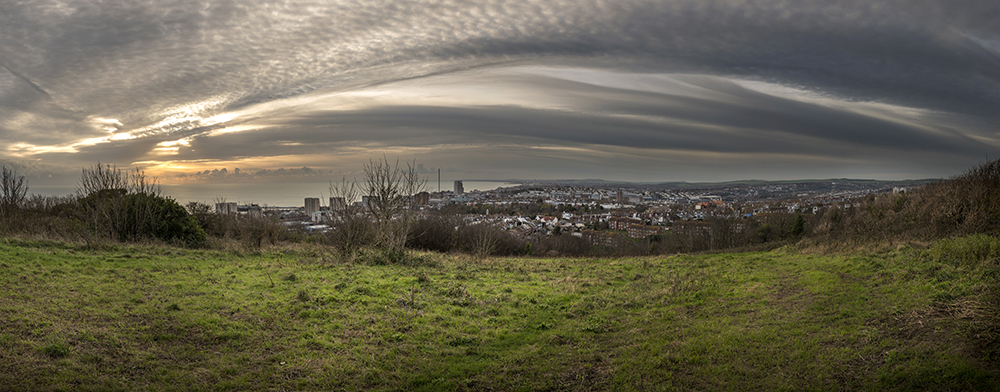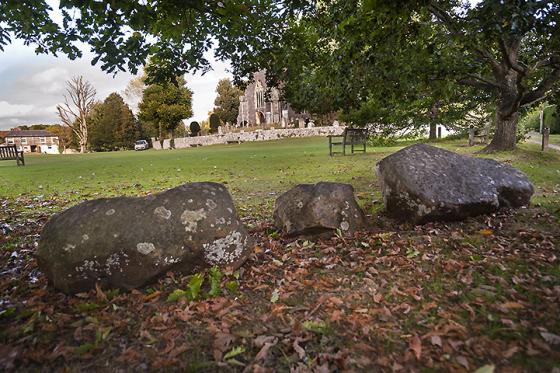
The dip in the railings of the Race Course run-off track indicate the faint remains of the 3rd ring of the Causewayed Enclosure.

The dip in the railings of the Race Course run-off track indicate the faint remains of the 3rd ring of the Causewayed Enclosure.

One of the areas dug in August 2014 on Whitehawk Hill, sadly yielding very little.

The view over Brighton & Hove from Whitehawk Hill. This is the same section that was dug in August 2014 in the previous photo.

The centre of the site is near the road (Manor Hill) that bisects the site, just South of Brighton Race Course. The notorious Whitehawk estate lies in the valley beyond, source of many burnt offerings.

Approximately between the 3rd and 4th ring with the communications mast to the South.

Whitehawk Neolithic Camp, Brighton 1935
Post-holes of palisade on inner rampart (in foreground); inner ditch (full of water), and second ditch beyond.
NOTE: the bank behind the ranging-pole is a recent feature.

A photo from the 20’s, looking west. This is when the site was only partly overlaid by allotments and paths, prior to it’s wholesale mash up during the 30’s, 50’s 60’s and 90’s by greedy bastard property developers. It is now largely covered by a notorious housing estate.
Someone has been generous with money....
Indiana Jones wannabes can dust off their trowels in an archaeological expedition aimed at delving deeper into 5,500-year-old remains in Brighton.
Thanks to a £99,300 grant from the Heritage Lottery Fund, local residents are being encouraged to work on a Time Team type project
Those taking part will work with professional and skilled volunteers in finding out more about Whitehawk Hill.
The aim, according to the Latest website, is to focus on the collection of objects excavated from the Neolithic site in the 1920s and 1930s.
Experts believe the land, near Brighton racecourse, used to be used for ritual ceremonies 500 years before Stonehenge was created.
It is also thought to be one of Britain’s first farming communities.
Stuart McLeod, head of the Heritage Lottery Fund South East, said: “Whitehawk Hill holds hidden clues as to the way our ancestors lived and how the community around here developed into what it is today.
“By delving into this history, volunteers will not only expand their knowledge and learn lots of new skills, but it will also provide a unique record of the area for others to learn, enjoy and be inspired by.”
The Whitehawk Camp partnership is made up of the Centre for Applied Archaeology, University College London, Brighton and Hove City Council’s Royal Pavilion and Museums and Brighton and Hove Archaeological Society.
Over the next 12 months, a series of events will take place which will focus on the biodiversity of Whitehawk Hill and the site’s relationship with the wider downland landscape
Volunteers will also be recruited to catalogue and examine archaeological finds, undertake geophysical survey, excavate archaeological remains and carry out conservation work to the monument.
Dr Dominic Perring, director of the UCL Centre for Applied Archaeology, said: “This is what archaeology should be about: a chance for everyone to participate in the adventure of discovery on a really important site.
“There are some fantastic events planned, and we look forward to learning a lot more about what happened at Brighton in the early New Stone Age.”
Councillor Geoffrey Bowden, chair of Brighton and Hove City Council’s Economic Development and Culture Committee, said: “Whitehawk Camp, older than Stonehenge, is on our doorstep and we are delighted that, with our partners, we have been successful in securing funds to increase understanding and highlight the importance of this historical site.
“This promises to be a real community effort and there will be opportunities for people to get involved in workshops at Brighton Museum and Art Gallery to study objects excavated from the site in the ’20s and ’30s, a community excavation at the site, and a range of other activities.”
For more details visit
ucl.ac.uk/caa/whitehawk-hlf
Except they have not filled in the details yet, but there is a nice reconstruction of the causewayed enclosure....
- See more at: brightonandhovenews.org/2014/04/18/time-team-wanted-for-brighton-dig/28992?#sthash.wPhAFnLQ.dpuf
I was going to post about Whitehawk more than a year ago after I volunteered for the dig which took place there in August 2014. I refrained from doing so at the time as I was supposed to be photographing (for Brighton Museum) the ‘more interesting artefacts’ which they hoped to uncover in the process of the dig. Sadly, despite intensive digging in 3 separate areas on Whitehawk Hill nothing particularly interesting was found. Geo-physics had shown up some anomalies on the Southern side of the hill which the archaeologists hoped might be a fifth outer ring, but this proved to be unfounded. Most of the very small things found were pieces of worked flints (possibly Neolithic), masses of broken glass, the inevitable willow-pattern ceramics shards and miscellaneous bits of ironware which were probably bits of broken gardening tools (most of the hill has been given over to allotments in the past and still is today). I personally found a 1945 farthing which back then would have bought you a whole house in Brighton. The other thing that was found in abundance were pieces of relatively modern cars and scooters which is quite interesting in itself. The practice of sacrificing expensive offerings to the gods on this site was still happening in the here and now, a clearly continuing tradition, except now they like to torch them first rather than burying them or flinging them into a watery place.
As stated in older posts there’s not much to suggest that you’re standing in a Causewayed Enclosure when you’re up there as most of it has been encroached upon by modern progress, allotments and the enlargement of Brighton Race Course, but here and there you’ll notice a slight undulation, a small squeak to remind you of the sheer scale of the site. The positioning of it too, is wonderful and a true focal point, commanding expansive views over the sea and South Downs of which it forms part. The panoramic images posted here were commissioned recently by Brighton Museum for educational purposes to highlight the importance of this truly ancient and wonderful place.
i would agree with a previous poster that it can be hard to work was going on a whitehawk. there has been a lot of development, with a housing estate, allotments and a radio tower covering much of the hill. it’s unfortunate, because whitehawk really is a magical place.
i would surmise that hollingbury hillfort was where people lived and whitehawk was where they partied. with the river in between the sites, down in the valley.
whitehawk has a strange ceremonial feel which you can still catch if you walk down beside the racecourse towards the sea. the racecourse seems to have been built upon or next to the old cursus, as a it curves round the top of sheepcote valley.
i found dave bangs’ book ‘Whitehawk Hill. Where the Turf Meets the Surf: A Landscape History & Natural History of Brighton’s Most Remarkable Downland Survival’ mighty helpful in getting a feel for the hill, but unfortunately i think it is now out of print.
basically, the radio mast stands about dead centre in what used to be the henge or circular fort, with some rings around it. a couple of patches of a few of the rings remain next to manor hill road. and that’s about it.
I’ve walked my dogs several days a week for 6 years around the area and couldn’t tell you for sure where the hillfort is... there has been so much other landscaping in the area especially the racecourse and allotments. A ridge that may be the hillfort is visible from the north of manor road and is disected by the road. Ancient pathways are kind of visible along the ridges of the downs around here though, notably Juggs Road that has been used up to more recent times (when Brighton was still a fishing village) for taking fish across the downs from Brighton to Lewes.
I doubt there’s much left to see of this Neolithic causewayed camp, seeing as how it’s surrounded by houses and the racecourse. It was excavated in the 30s and the detail that interested me was that two fossilised sea urchins had been buried with some people. Folklore has it that fossil sea urchins are ‘fairy loaves’ or ‘fairy stones’. I guess they are pretty strange – obviously not ordinary rocks, but they look like something living or manmade. Also without their spines they bear little resemblence to anything alive that you’re familiar with, particularly if you’re not living by the sea (like at the Five Knolls in Bedfordshire). I’ve also read that people have kept them in their houses so that their loaflike similarity would ensure the occupants would never go without bread (or food, no doubt). They were also kept in dairies to stop the milk going sour.
Of course, none of this need have any relevance to the reason these prehistoric people took them to their graves. They presumably serve no hands-on practical purpose? so we have to assume that they did hold a symbolic value of some kind (even if it could have been merely that they were weird and interesting?).
It’s a featured article




































